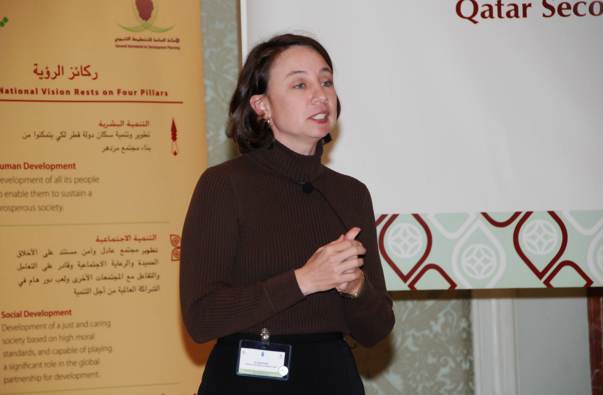Sustainable Development in Qatar "Achievable" Says Dr. Renee Richer
March 2009

Dr. Renee Richer presents the findings of her chapter on sustainable
development to the audience at the national seminar, where the contents
of the Second National Human Development Report were discussed.
Qatar is growing at a frenetic pace. Life expectancy and standard of living are on the rise. The country’s population increased an estimated 79 percent between 2006 and 2008, its GDP growth rate averages over 18 percent, and building construction and road expansion are ubiquitous.
But is economic development in Qatar at the expense of the social well-being of the population? And how can Qatar balance today’s growth against the resources available to future generations?
Dr. Renee Richer, WCMC-Q assistant professor of biology, addresses these and other issues in a chapter on sustainable development from Qatar’s “Second National Human Development Report” (HDR).
The authors of the report, prepared under the guidance of the Qatar General Secretariat for Development Planning (GSDP), recently presented its content in a national seminar entitled “Achieving the Environmental Development Outcomes of the Qatar National Vision 2030”. The seminar allowed the public to hear and comment on the report, and the results of that open discussion are to be incorporated in the report’s findings.
With a majority of Qatar’s economy based on natural capital—in this case, non-renewable natural resources—Dr. Richer asserts that the country’s leadership must maintain overall capital levels by investing profits from these natural resources into other forms. These include durable capital such as physical infrastructure, human capital through its citizens’ education and skills, as well as financial capital.
“Qatar can approach sustainability if it invests the profits wisely,” she says.
There are financial incentives to sustainability, and she believes improved efficiencies can also improve the bottom line.
“Countries promoting stricter environmental standards have been able to capture a market share in technologies meeting those standards,” she adds.
Success, Dr. Richer says, will require stakeholder engagement and transparency, an improved and integrated set of indicators, and the creation and implementation of a comprehensive development plan.
But Dr. Richer warns that time is of the essence. The establishment of the regulatory framework to guide development already lags dangerously behind the pace of growth.
The good news: “Qatar is a relatively small country with bold and forward-thinking leadership which has the ability to make and implement these decisions. Qatar is really in a unique situation where she can make it happen.”
Dr. Richer came to the attention of the GSDP through the reputation of her 2008 paper, “Conservation in Qatar: Impacts of Increasing Industrialization”. Her background paper and input contributed to the production of the HDR.
This and subsequent HDRs will inform the National Strategy to realize the Qatar National Vision – a statement of strategic goals Qatar hopes to achieve by the year 2030, encompassing four “pillars” of development: human, social, economic and environmental.
